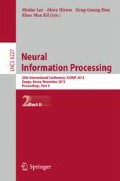Abstract
Physiological signals have certain prominent characteristics that distinguish them from other types of physiological signals which are familiar to experts and assessed by inspection. The aim of this paper is to develop a computational model that can distinguish electrocardiogram, galvanic skin response and blood pressure signals acquired from sensors as well as detect corrupted signals which can arise due to hardware problems including sensor malfunction. Our work also investigates the impact of the signal modeling for various time lengths and determines an optimal signal time length for classification. This provides a method for automatic detection of corrupted signals during signal data collection which can be incorporated as a support tool during real-time sensor data acquisition.
Access this chapter
Tax calculation will be finalised at checkout
Purchases are for personal use only
Preview
Unable to display preview. Download preview PDF.
References
Jacobson, M.: Analysis and classification of physiological signals using wavelet transforms. In: International Conf. on Electronics, Circuits and Systems, pp. 906–909 (2003)
Killgore, W.D., et al.: Insomnia-related complaints correlate with functional connectivity between sensory–motor regions. NeuroReport 24, 233–240 (2013)
Sharma, N., Gedeon, T.: Objective measures, sensors and computational techniques for stress recognition and classification: A survey. Computer Methods and Programs in Biomedicine 108, 1287–1301 (2012)
Wagner, J., Kim, J., André, E.: From physiological signals to emotions: Implementing and comparing selected methods for feature extraction and classification. In: Int. Conf. on Multimedia and Expo, pp. 940–943 (2005)
Gouizi, K., Bereksi Reguig, F., Maaoui, C.: Emotion recognition from physiological signals. Journal of Medical Engineering & Technology 35, 300–307 (2011)
Sweeney, K.T., et al.: Intelligent artifact classification for ambulatory physiological signals. In: Int. Conf. of the IEEE Engineering in Medicine and Biology Society, pp. 6349–6352 (2010)
Sharma, N., Gedeon, T.: Modeling Stress Recognition in Typical Virtual Environments. In: Int. Conf. on Pervasive Computing Technologies for Healthcare (2013)
Healey, J.A., Picard, R.W.: Detecting stress during real-world driving tasks using physiological sensors. IEEE Transactions on Intelligent Transportation Systems 6, 156–166 (2005)
Bersak, D., et al.: Intelligent biofeedback using an immersive competitive environment. In: Designing Ubiquitous Computing Games Workshop, USA (2001)
Shi, Y., et al.: Galvanic skin response (GSR) as an index of cognitive load. In: CHI 2007 Extended Abstracts on Human Factors in Computing Systems, USA, pp. 2651–2656 (2007)
Lin, T., et al.: Do physiological data relate to traditional usability indexes? In: Australia Conference on Computer-Human Interaction, pp. 1–10 (2005)
Miller, L.H., Shmavonian, B.M.: Replicability of two GSR indices as a function of stress and cognitive activity. Journal of Personality and Social Psychology, 753–756 (1965)
McEwen, B.S., Sapolsky, R.M.: Stress and cognitive function. Journal of Current Opinion in Neurobiology 5, 205–216 (1995)
Author information
Authors and Affiliations
Editor information
Editors and Affiliations
Rights and permissions
Copyright information
© 2013 Springer-Verlag Berlin Heidelberg
About this paper
Cite this paper
Sharma, N., Gedeon, T. (2013). Classification of Physiological Sensor Signals Using Artificial Neural Networks. In: Lee, M., Hirose, A., Hou, ZG., Kil, R.M. (eds) Neural Information Processing. ICONIP 2013. Lecture Notes in Computer Science, vol 8227. Springer, Berlin, Heidelberg. https://doi.org/10.1007/978-3-642-42042-9_63
Download citation
DOI: https://doi.org/10.1007/978-3-642-42042-9_63
Publisher Name: Springer, Berlin, Heidelberg
Print ISBN: 978-3-642-42041-2
Online ISBN: 978-3-642-42042-9
eBook Packages: Computer ScienceComputer Science (R0)

